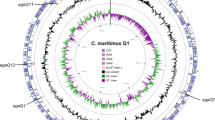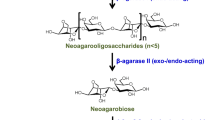Abstract
Recently, agarose-containing macroalgae have gained attention as possible renewable sources for bioethanol-production because of their high polysaccharide content. Complete hydrolysis of agarose produces two monomers, D-galactose (D-Gal) and 3,6-anhydro-L-galactose (L-AnG). However, at present, bioethanol yield from agarophyte macroalgae is low due to the inability of bioethanolproducing microorganisms to convert non-fermentable sugars, such as L-AnG, to bioethanol. Therefore, to increase the bioethanol productivity of agarophytes, it is necessary to determine how agar-degrading microorganisms metabolize L-AnG, and accordingly, construct recombinant microorganisms that can utilize both D-Gal and L-AnG. Previously, we isolated a novel microorganism belonging to a new genus, Postechiella marina M091, which hydrolyzes and metabolizes agar as the carbon and energy source. Here, we report a comparative genomic analysis of P. marina M091, Pseudoalteromonas atlantica T6c, and Streptomyces coelicolor A3(2), of the classes Flavobacteria, Gammaproteobacteria, and Actinobacteria, respectively. In this bioinformatic analysis of these agarolytic bacteria, we found candidate common genes that were believed to be involved in L-AnG metabolism. We then experimentally confirmed the enzymatic function of each gene product in the L-AnG cluster. The formation of two key intermediates, 2-keto-3-deoxy-L-galactonate and 2-keto-3-deoxy-D-gluconate, was also verified using enzymes that utilize these molecules as substrates. Combining bioinformatic analysis and experimental data, we showed that L-AnG is metabolized to pyruvate and D-glyceraldehyde-3-phosphate via six enzymecatalyzed reactions in the following reaction sequence: 3,6-anhydro-L-galactose → 3,6-anhydro-L-galactonate → 2-keto-3-deoxy-L-galactonate → 2,5-diketo-3-deoxy-L-galactonate → 2-keto-3-deoxy-D-gluconate → 2-keto-3-deoxy-6-phospho-D-gluconate → pyruvate + D-glyceraldehyde-3- phosphate. To our knowledge, this is the first report on the metabolic pathway of L-AnG degradation.
Similar content being viewed by others
References
Roesijadi, G., S. B. Jones, L. J. Snowden-Swan, and Y. Zhu (2010) Macroalgae as A Biomass Feedstock: A Preliminary Analysis. Pacific Northwest National Laboratory.
Meinita, M. D. N., B. Marhaeni, T. Winanto, G. T. Jeong, M. N. A. Khan, and Y. K. Hong (2013) Comparison of agarophytes (Gelidium, Gracilaria, and Gracilariopsis) as potential resources for bioethanol production. J. Appl. Phycol. 25: 1957–1961.
Trivedi, N., V. Gupta, C. R. Reddy, and B. Jha (2013) Enzymatic hydrolysis and production of bioethanol from common macrophytic green alga Ulva fasciata Delile. Bioresour. Technol. 150: 106–112.
Choi, W. Y., D.-H. Kang, and H.-Y. Lee (2013) Enhancement of the saccharification yields of Ulva pertusa Kjellmann and rape stems by the high-pressure steam pretreatment process. Biotechnol. Bioproc. Eng. 18: 728–735.
Wargacki, A. J., E. Leonard, M. N. Win, D. D. Regitsky, C. N. Santos, P. B. Kim, S. R. Cooper, R. M. Raisner, A. Herman, A. B. Sivitz, A. Lakshmanaswamy, Y. Kashiyama, D. Baker, and Y. Yoshikuni (2012) An engineered microbial platform for direct biofuel production from brown macroalgae. Science 335: 308–313.
Enquist-Newman, M., A. M. Faust, D. D. Bravo, C. N. Santos, R. M. Raisner, A. Hanel, P. Sarvabhowman, C. R. Le, D. D., S. R. Cooper, L. Peereboom, A. Clark, Y. Martinez, J. Goldsmith, M. Y. Cho, P. D. Donohoue, L. Luo, B. Lamberson, P. Tamrakar, E. J. Kim, J. L. Villari, A. Gill, S. A. Tripathi, P. Karamchedu, C. J. Paredes, V. Rajgarhia, H. K. Kotlar, R. B. Bailey, D. J. Miller, N. L. Ohler, C. Swimmer, and Y. Yoshikuni (2014) Efficient ethanol production from brown macroalgae sugars by a synthetic yeast platform. Nature 505: 239–243
Ra, C. H. and S.-K. Kim (2013) Optimization of pretreatment conditions and use of a two-stage fermentation process for the production of ethanol from seaweed, Saccharina japonica. Biotechnol. Bioproc. Eng. 18: 715–720.
Wei, N., J. Quarterman, and Y.-S. Jin (2013) Marine macroalgae: An untapped resource for producing fuels and chemicals. Trends Biotechnol. 31: 70–77.
Hwang, H. J., S. Y. Lee, S. M. Kim, and S. B. Lee (2011) Fermentation of seaweed sugars by Lactobacillus species and the potential of seaweed as a biomass feedstock. Biotechnol. Bioproc. Eng. 16: 1231–1239.
Cole, K. M. and R. G. Sheath (1990) Biology of the Red Algae. Cambridge University Press, NY, USA.
Araki, C. (1956) Structure of the agarose constituent of agar-agar. Bull. Chem. Soc. Japan 29: 543–544.
Hamer, G. K., S. S. Bhattacharjee, and W. Yaphe (1977) Analysis of the enzymic hydrolysis products of agarose by 13C-n.m.r. spectroscopy. Carbohydr. Res. 54: C7–C10.
Chi, W. J., Y. K. Chang, and S. K. Hong (2012) Agar degradation by microorganisms and agar-degrading enzymes. Appl. Microbiol. Biotechnol. 94: 917–930.
Day, D. F. and W. Yaphe (1975) Enzymatic hydrolysis of agar: purification and characterization of neoagarobiose hydrolase and p-nitrophenyl α-galactoside hydrolase. Can. J. Microbiol. 21: 1512–1518.
O’Nell, A. N. and D. K. R. Stewart (1956) On the structure of agar from Gelidium cartilaginium. Can. J. Chem. 34: 1700–1703.
Siegel, B. Z. and S. M. Siegel (1973) The chemical composition of algal cell walls. Crit. Rev. Microbiol. 3: 1–26.
Park, J. H., J. Y. Hong, H. C. Jang, S. G. Oh, S. H. Kim, J. J. Yoon, and Y. J. Kim (2012) Use of Gelidium amansii as a promising resource for bioethanol: a practical approach for continuous diluteacid hydrolysis and fermentation. Bioresour. Technol. 108: 83–88.
Kumar, S., R. Gupta, G. Kumar, D. Sahoo, and R. C. Kuhad (2013) Bioethanol production from Gracilaria verrucosa, a red alga, in a biorefinery approach. Bioresour. Technol. 135: 150–156.
Lee, D. H., S. J. Cho, S. M. Kim, and S. B. Lee (2012) Postechiella marina gen. nov., sp. nov., isolated from seawater. Int. J. Syst. Evol. Microbiol. 62: 1528–1535.
Yaphe, W. (1957) The use of agarase from Pseudomonas atlantica in the identification of agar in marine algae (Rhodophyceae) Can. J. Microbiol. 3: 987–993.
Morrice, L. M., M. W. McLean, F. B. Williamson, and W. F. Long (1983) β-Agarases I and II from Pseudomonas atlantica: Purifications and some properties. Eur. J. Biochem. 135: 553–558.
Stanier, R. Y. (1942) Agar-decomposing strains of the Actinomyces coelicolor species-group. J. Bacteriol. 44: 555–570.
Kim, S. M., K. H. Paek, and S. B. Lee (2012) Characterization of NADP+-specific L-rhamnose dehydrogenase from the thermoacidophilic Archaeon Thermoplasma acidophilum. Extremophiles 16: 447–454
Sambrook, J. and D. W. Russell (2001) Molecular Cloning: A Laboratory Manual. 3rd ed., Cold Spring Harbor Laboratory Press, Cold Spring Harbor, NY, USA.
Bradford, M. M. (1976) A rapid and sensitive method for the quantitation of microgram quantities of protein utilizing the principle of protein-dye binding. Anal. Biochem. 72: 248–254.
Sugano, Y., H. Kodama, I. Terada, Y. Yamazaki, and M. Noma (1994) Purification and characterization of a novel enzyme, a-neoagarooligosaccharide hydrolase (α-NAOS hydrolase), from a marine bacterium, Vibrio sp. strain JT0107. J. Bacteriol. 176: 6812–6818.
Duckworth, M. and W. Yaphe (1970) Thin-layer chromatographic analysis of enzymic hydrolysates of agar. J. Chromatogr. 49: 482–487.
Skoza, L. and S. Mohos (1976) Stable thiobarbituric acid chromophore with dimethyl sulphoxide. Application to sialic acid assay in analytical de-O-acetylation. Biochem. J. 159: 457–462.
Kim, S. and S. B. Lee (2006) Characterization of Sulfolobus solfataricus 2-keto-3-deoxy-D-gluconate kinase in the modified Entner- Doudoroff pathway. Biosci. Biotechnol. Biochem. 70: 1308–1316.
Noh, M., J. H. Jung, and S. B. Lee (2006) Purification and characterization of glycerate kinase from the thermoacidophilic archaeon Thermoplasma acidophium: an enzyme belonging to the second glycerate kinase family. Biotechnol. Bioproc. Eng. 11: 344–350.
Buchanan, C. L., H. Connaris, M. J. Danson, C. D. Reeve, and D. W. Hough (1999) An extremely thermostable aldolase from Sulfolobus solfataricus with specificity for non-phosphorylated substrates. Biochem. J. 343: 563–570.
Lim, S. H. (2008) Thermostable aldolases from Thermoplasma acidophilum. Master Thesis, POSTECH, Korea.
Karlin, S., J. Mrazek, A. Campbell, and D. Kaiser (2001) Characterizations of highly expressed genes of four fast-growing bacteria. J. Bacteriol. 183: 5025–5040.
Kumar, S., M. Nei, J. Dudley, and K. Tamura (2008) MEGA: A biologist-centric software for evolutionary analysis of DNA and protein sequences. Brief Bioinform. 9: 299–306.
Ducatti, D. R., A. Massi, M. D. Noseda, M. E. Duarte, and A. Dondoni (2009) Production of carbohydrate building blocks from red seaweed polysaccharides. Efficient conversion of galactans into C-glycosyl aldehydes. Org. Biomol. Chem. 7: 576–588.
Kim, S. and S. B. Lee (2005) Identification and characterization of Sulfolobus solfataricus D-gluconate dehydratase: A key enzyme in the non-phosphorylated Entner-Doudoroff pathway. Biochem. J. 387: 271–280.
Jung, J. H. and S. B. Lee (2006) Identification and characterization of Thermoplasma acidophilum glyceraldehyde dehydrogenase: A new class of NADP+-specific aldehyde dehydrogenase. Biochem. J. 397: 131–138.
Jung, J. H. and S. B. Lee (2005) Identification and characterization of Thermoplasma acidophilum 2-keto-deoxy-D-gluconate kinase: a new class of sugar kinases. Biotechnol. Bioproc. Eng. 10: 535–539.
Condemine, G., N. Hugouvieuxcottepattat, and J. Robert-Baudouy (1984) An enzyme in the pectinolytic pathway of Erwinia chrysanthemi: 2-keto-3-deoxygluconate oxidoreductase. J. Gen. Microbiol. 130: 2839–2844.
Petsko, G. A. and D. Ringe (2004) Protein Structure and Function. p. 136. New Science Press, London.
Entner, E. and M. Doudoroff (1952) Glucose and gluconic acid oxidation of Pseudomonas saccharophila. J. Biol. Chem. 196: 853–862.
Peekhaus N. and T. Conway (1998) What’s for dinner?: Entner- Doudoroff metabolism in Escherichia coli. J. Bacteriol. 180: 3495–3502.
Kim, S. and S. B. Lee (2008) Identification and characterization of the bacterial D-gluconate dehydratase in Achromobacter xylosoxidans. Biotechnol. Bioproc. Eng. 13: 436–444.
Andberg, M., H. Maaheimo, H. Boer, M. Penttilä, A. Koivula, and P. Richard (2012) Characterization of a novel Agrobacterium tumefaciens galactarolactone cycloisomerase enzyme for direct conversion of D-galactarolactone to 3-deoxy-2-keto-L-threohexarate. J. Biol. Chem. 287: 17662–17671.
Hilditch, S., S. Berghall, N. Kalkkinen, M. Penttila, and P. Richard (2007) The missing link in the fungal D-galacturonate pathway: Identification of the L-threo-3-deoxy-hexulosonate aldolase. J. Biol. Chem. 282: 26195–26201.
Author information
Authors and Affiliations
Corresponding author
Rights and permissions
About this article
Cite this article
Lee, S.B., Cho, S.J., Kim, J.A. et al. Metabolic pathway of 3,6-anhydro-L-galactose in agar-degrading microorganisms. Biotechnol Bioproc E 19, 866–878 (2014). https://doi.org/10.1007/s12257-014-0622-3
Received:
Revised:
Accepted:
Published:
Issue Date:
DOI: https://doi.org/10.1007/s12257-014-0622-3




